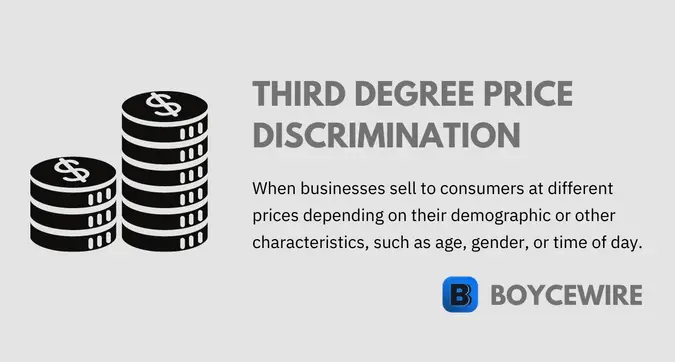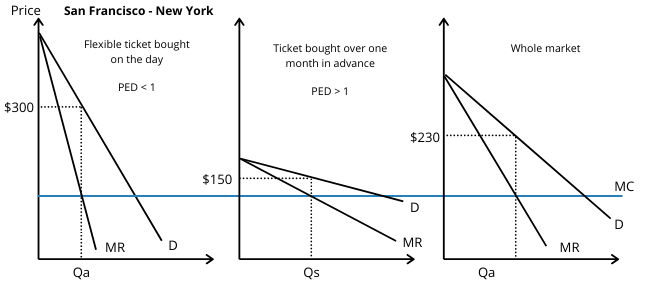Table of Contents ![]()
Third Degree Price Discrimination: Definition, Examples & Graph

What is Third Degree Price Discrimination
Third degree price discrimination is where a firm charges the consumer a different price based on which consumer group they are in. For example, cinema’s charge different prices to adults, seniors, and youths – whilst taxi drivers often charge a higher rate during peak hours.
Third degree price discrimination is the most common of all the types of price discrimination. It is commonly used by restaurants, cinemas, taxis, train tickets, and retailers – among others. This is because it is relatively easy to implement and is largely more effective at increasing custom than first and second degree price discrimination. Prices are more closely linked to the consumer’s elasticity of demand – meaning prices are adjusted to the consumers’ willingness to pay.
Although first degree price discrimination maximizes the revenue received from the consumer by extracting their maximum willingness to pay – it is not very feasible to implement in the real-world. Therefore, it is more of an abstract concept by which companies aim to achieve. Third degree price discrimination is as close as most companies can get the maximizing the consumers’ willingness to pay.
Key Points
- Third degree price discrimination is where firms charge consumers different prices based on their consumer group.
- Consumer groups include peak and non-peak times, adults, seniors, and youths.
- Firm must be able to segregate consumers based on their price elasticity of demand.
Conditions for Third Degree Price Discrimination
In order to be able to adopt third degree price discrimination, the firm must meet the following criteria:
- Ability to segment consumers into different groups.
- Ability to prevent resale.
First of all, the firm must be able to identify and be able to segment consumers into different groups. For example, cinemas are able to identify that seniors and youths have different elasticities of demand from adults – so charge lower prices.
Second of all, the firm must be able to prevent resale. For instance, a senior customer should not be able to buy a cheap ticket and then sell it on to an adult. In order to get around this, firms use ID rules whereby the customer has to provide evidence to prove they are within that consumer segment.
Third Degree Price Discrimination Graph
Third-degree price discrimination involves segment different groups who have different elasticities of demand. If we look at airline tickets for example, there are those who are more price-sensitive (elastic demand) and there are those who are not so sensitive to prices (inelastic demand).
With regards to airline tickets, business people are most likely to be willing and able to pay more for tickets. At the same time, they are usually the ones who book last minute – so airlines can charge a higher price to them.
For those who are more price-sensitive – they are more likely to book well in advance to get the best deals. This is why many airlines offer lower prices to those who book up to a year in advance. The customer gets a cheaper ticket and the airline benefits from increased cash flow.

The graph above demonstrates the segmentation between the two groups. In the first instance, there are business customers who are willing and able to pay a higher price for the ticket. They are less price-sensitive. The firm will therefore offer the tickets up to where marginal revenue is equal to marginal cost. This is because, at this point, the firm is no longer making any more money.
At this point, the price of the ticket would amount to $300 based on the business persons’ demand curve. Everything between this and the marginal cost can be seen as profit.
In the second instance, there are more price-sensitive consumers. This might be students for example. Their demand curve is must more elastic, meaning they are more sensitive to changes in price. So where marginal cost = marginal revenue, the price reaches $150. Everything below this is profit for the firm, but it is noticeable that the profit margins for these are much smaller.
Finally, there is the overall market, which is a combination of the inelastic demand of business people and the elastic demand of students.
Third Degree Price Discrimination Examples

Cinemas
Cinemas are another example of third-degree price discrimination. They do so by segmenting the market between children, adults, and seniors. Usually, children and seniors receive a discounted rate, which adults pay the highest price. The reason being is that children will most often come with an adult.
It is cheaper than child care and makes it cheaper overall for the adult to go to the cinema. Adults benefit from having to pay lower prices to bring their children, but the cinema also benefits from higher expenditures on related items such as popcorn. Quite simply, by offering children lower rates, it not only brings in more children but also more adults.
Restaurants
Some restaurants offer discounts for customers that come at a specific time. This might include a cheaper ‘lunch-time’ menu or some kind of ‘early-bird’ menu for customers who come during non-peak hours. This attracts customers who are more price-sensitive, whilst also benefiting the firm by utilizing its capacity during less busy hours. Some restaurants also offer discounts for veterans and healthcare workers.
Student Discounts
Most firms recognize that students demand is very elastic – meaning they are more sensitive to changes in price. As a result, many firms offer substantial discounts for students in order to win their business. Not only does this win their custom in the short-term, but it could also win their custom for their adult life too. After all, students are likely to be curious and try new brands and experiment. If one firm does well with their offering, they may in fact win a customer for life.
Taxis
Another example of third-degree price discrimination are taxi drivers. They use timing to help segment the market between peak and non-peak hours. During peak hours, taxi drivers are likely to be busy, and customers are in a rush. In turn, this drives up the willingness of customers to pay higher fees – thereby creating an inelastic demand curve.
By contrast, in non-peak hours, customers will most likely be traveling at their leisure and not have the same urgency as those traveling in peak hours. Therefore, their demand curve is more elastic – meaning they are more sensitive to changes in price.
Related Topics
FAQs
Third degree price discrimination is a type of pricing strategy where a business charges different prices depending on the consumers characteristics or segmentation. For example, this might be age, gender, location, or occupation. Depending on the firms strategy, each segment will be charged a different price.
Some common examples of third degree price discrimination include cinema tickets, student discounts, restaurants, and taxis.
There are three main types of price discrimination: first, second, and third degree. First degree price discrimination is where each consumer pays the absolute maximum they are willing to pay. Second degree price discrimination is based on the quantity of goods such as bulk discounts. And finally, third degree price discrimination involves charging different prices to different consumer segments.
The two main conditions of price discrimination are:
– Ability to segment consumers into different groups.
– Ability to prevent resale.
About Paul
Paul Boyce is an economics editor with over 10 years experience in the industry. Currently working as a consultant within the financial services sector, Paul is the CEO and chief editor of BoyceWire. He has written publications for FEE, the Mises Institute, and many others.

Further Reading
 BATNA - BATNA, or Best Alternative to a Negotiated Agreement, is the alternative course of action that a party will pursue if…
BATNA - BATNA, or Best Alternative to a Negotiated Agreement, is the alternative course of action that a party will pursue if…  Social Capital: Definition, Types & Examples - Social capital refers to the links and bonds formed through friendships and acquaintances.
Social Capital: Definition, Types & Examples - Social capital refers to the links and bonds formed through friendships and acquaintances.  Finance Charge - A finance charge is the fee or interest imposed by a lender on a borrower for the use of credit…
Finance Charge - A finance charge is the fee or interest imposed by a lender on a borrower for the use of credit… 